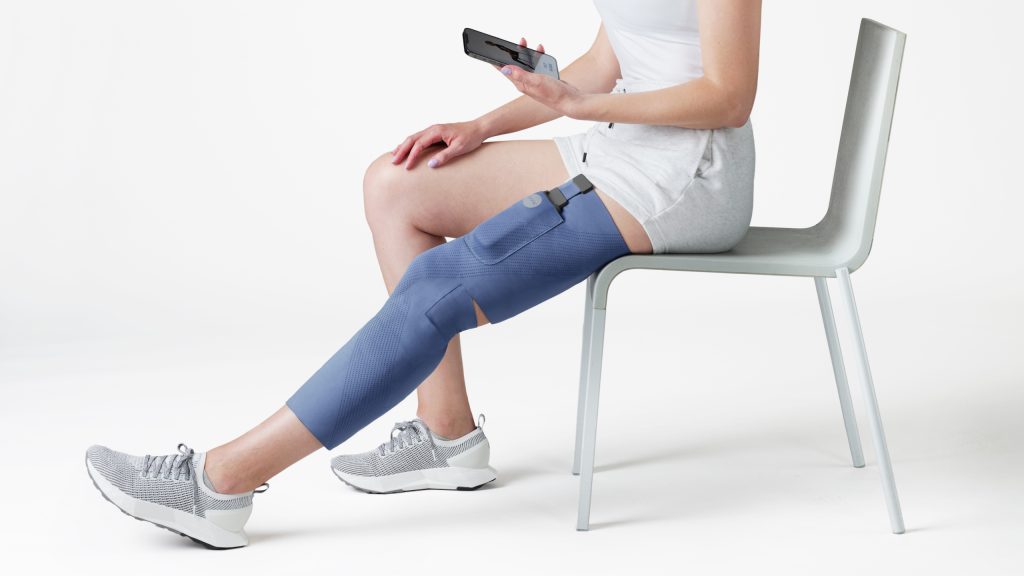
Functional Electrical Stimulation, or FES for short, is a powerful rehabilitation tool that helps individuals with neuromuscular impairments regain mobility and muscle function. Although FES itself is not new (more on that below), the way it’s delivered has advanced greatly. Over the last several years, a number of new assistive technologies—including an FES bike and Neural Sleeve—have emerged.
Understanding FES: A Quick Overview
Before diving into the differences between the FES bike and the Cionic Neural Sleeve, it’s important to understand what Functional Electrical Stimulation is. FES involves using electrical impulses to stimulate nerves and/or muscles, resulting in a muscle contraction.
This helps individuals with MS, stroke, spinal cord injuries, cerebral palsy, or other neurological conditions increase strength, improve circulation, and potentially restore some level of voluntary movement.
FES Clinical Use: History, Early Experiments, and Advancements in Technology and Application
The history of FES is a fascinating journey that spans centuries, involving the convergence of neuroscience, engineering, and rehabilitation science. From its early conceptual beginnings to its current applications in medical rehabilitation, FES has developed into a significant therapeutic tool for individuals with neuromuscular impairments.
Early Beginnings: The Concept of Electrical Stimulation
The concept of using electrical currents to stimulate muscles and nerves dates back to the 18th century. In 1791, Italian physician and physicist Luigi Galvani discovered that electrical currents could cause muscle contractions in frogs, a phenomenon he termed “animal electricity.”
This discovery laid the foundation for the development of electrophysiology and the understanding of how electricity interacts with biological tissues.
19th to Early 20th Century: Early Experiments and Theories
Throughout the 19th and early 20th centuries, researchers experimented with electrical stimulation to explore its therapeutic potential. By the early 1900s, there were initial attempts to use electrical currents on paralyzed muscles in humans.
However, these efforts were largely experimental, with inconsistent results due to the lack of understanding of optimal stimulation parameters and technological limitations.
1960s: Birth of Modern Functional Electrical Stimulation
The modern era of FES began in the 1960s. Dr. Liberson and his team pioneered the first practical use of FES for functional movement by developing a device that stimulated the peroneal nerve to help patients with “foot drop” lift their foot while walking.
This marked the first significant application of FES for improving functional mobility in individuals with mobility differences. Around the same time, FES was also being explored for restoring upper limb function in patients with spinal cord injuries (SCI).
1970s-1980s: Technological Advancements
The 1970s and 1980s brought significant advancements in FES technology and its clinical applications. The advent of microprocessors during this period allowed for more precise control over electrical stimulation, enhancing the effectiveness and user-friendliness of FES devices.
Clinical research during this era began documenting the benefits of FES in improving muscle strength, reducing muscle atrophy, and enhancing cardiovascular health.
1990s: Expanding the Applications of FES
In the 1990s, FES research expanded to cover additional applications, such as bladder and bowel control, respiratory function, and cardiovascular conditioning.
FES cycling became popular for improving cardiovascular fitness and muscle health in individuals with lower limb paralysis. The development of implantable FES systems provided more long-term stimulation, often improving outcomes for users.
2000s – Present: Integration with Robotics, Increased Personalization, & More
The 2000s marked the integration of FES with neuroprosthetics, robotics, and brain-computer interfaces (BCIs). In recent years, the focus of FES has shifted towards personalization, portability, and accessibility. Modern FES devices have become smaller, more portable, and easier to use, allowing for home-based rehabilitation.
Devices like bionic clothing and portable FES bikes have made it possible for users to continue therapy outside clinical settings. The latest devices are equipped with software that offers personalized stimulation programs tailored to each user’s needs, expanding FES’s use in conditions like stroke, multiple sclerosis, and cerebral palsy.
Introducing The Cionic Neural Sleeve

The Cionic Neural Sleeve is a bionic clothing garment that wraps around the leg and looks similar to a sports legging. It has integrated electrodes that sense, analyze, and augment movement. Indicated to improve walking, increase strength and range of motion, and facilitate muscle re-education, the Cionic Neural Sleeve can be a great tool for individuals with muscle weakness or foot drop due to conditions impacting the central nervous system.
Benefits of the Cionic Neural Sleeve:
- Comfortable and Convenient: Lightweight and easy to wear, the Neural Sleeve can be used at home, in a clinic, or on the go.
- Targeted Muscle Stimulation: The Cionic Neural Sleeve is the first system to target the four major muscle groups of the leg, making it ideal for both upper and lower leg rehabilitation.
- Daily Activity Integration: Can be used while performing daily activities, enhancing functional movement training.
- Customizable Programs: The Cionic Neural Sleeve comes with customizable settings, allowing for varied stimulation programs and gait protocols tailored to individual needs.
Limitations of the Cionic Neural Sleeve:
- Limited to Lower Extremities: The Cionic Neural Sleeve targets the hamstrings, quadriceps, shin, and calf muscles. Currently, the system does not directly target hip flexors, glutes, back, or upper extremities, though some users have noticed improvements to these areas as overall walking mechanics improve. For people who want to stay in the know about future products from CIONIC, be sure to join the newsletter.
- Lower Intensity Cardiovascular Impact: Walking with the Cionic Neural Sleeve may not provide the same level of cardiovascular exertion as biking. However, there is a Cycle program in the CIONIC App and a full suite of functional exercises, so the Neural Sleeve can act as its own FES bike for people interested in improving their cardiovascular fitness. Additionally, with improved walking from the sleeve, many users report less fatigue, allowing them to walk further and faster.
- Learning Curve: Proper placement and adjustment are crucial for effective stimulation and may require repositioning in the beginning.
Introducing MyoCycle: An FES Bike for Home Use

The MyoCycle is designed for people with muscle weakness or paralysis caused by disorders such as spinal cord injury, stroke, or multiple sclerosis.
When using the MyoCycle Home, you will place electrodes on the skin over the major leg muscles. Thes include the quadriceps, hamstrings, shins, etc. The electrical impulses cause the muscles to contract, allowing the user to pedal the bike even if they cannot do so voluntarily.
Benefits of Using an FES Bike:
- Cardiovascular Conditioning: The repetitive cycling motion provides cardiovascular benefits, which are crucial for overall health.
- Muscle Strength and Endurance: Regular use helps strengthen muscles, and can potentially slow down and/or prevent muscle atrophy in individuals with paralysis.
- Improved Circulation: The pedaling motion aids in enhancing blood flow, reducing the risk of blood clots.
- Spasticity Management: Regular muscle stimulation can help in reducing muscle spasms and stiffness. Additionally, all MyoCycle models include automatic spasm detection.
Limitations of the FES Bike:
- Bulky and Space-Consuming: FES bikes such as the MyoCycle are generally large, stationary devices that require dedicated space.
- Accessibility and Cost: The cost can be high, and not all insurance plans cover them. Accessibility might also be an issue for home use.
- Lower Body Focus: Primarily targets the lower body, which may not be sufficient for individuals needing upper body rehabilitation.
FES Bike vs. The Cionic Neural Sleeve: Which is Right for You?
Choosing between an FES bike and the Cionic Neural Sleeve depends on several factors, including your rehabilitation goals, mobility level, and budget.
- For Lower Body Rehabilitation and Cardiovascular Fitness: If your primary goal is to strengthen your lower body muscles, improve cardiovascular health, and manage spasticity, either option could be a good fit for you. The FES Bike is particularly beneficial for those with spinal cord injuries or significant lower limb impairments that limit the ability to walk.
- For Targeted Muscle Rehabilitation and Improved Walking: If you need more targeted stimulation to specific muscle groups, to address muscle weakness or gait impairments such as foot drop, the Cionic Neural Sleeve might be more appropriate. The software-steered stimulation not only improves gait and range of motion; it’s also indicated to facilitate muscle re-education.
- Budget and Space Considerations: The Cionic Neural Sleeve is less expensive than other FES devices for mobility and requires less space than an FES bike. This often makes it a more practical option for home use, especially for those with limited space.
- For Everyday Use: you can only use the FES Bike while you are at home and physically active on the bike. If you need a mobility solution that can support most activities of daily living, such as going to a job, caring for a family member, running errands, and more, the Neural Sleeve can provide needed care anywhere you go.
Conclusion
Both FES devices are valuable tools in neurorehabilitation. The choice between the Neural Sleeve and an FES bike depends on your specific needs, whether it’s building cardiovascular strength, targeting specific muscle groups, improving walking, or integrating rehabilitation into your daily routine.
Consulting with a healthcare professional or rehabilitation specialist can provide personalized guidance on which device will best suit your needs.





